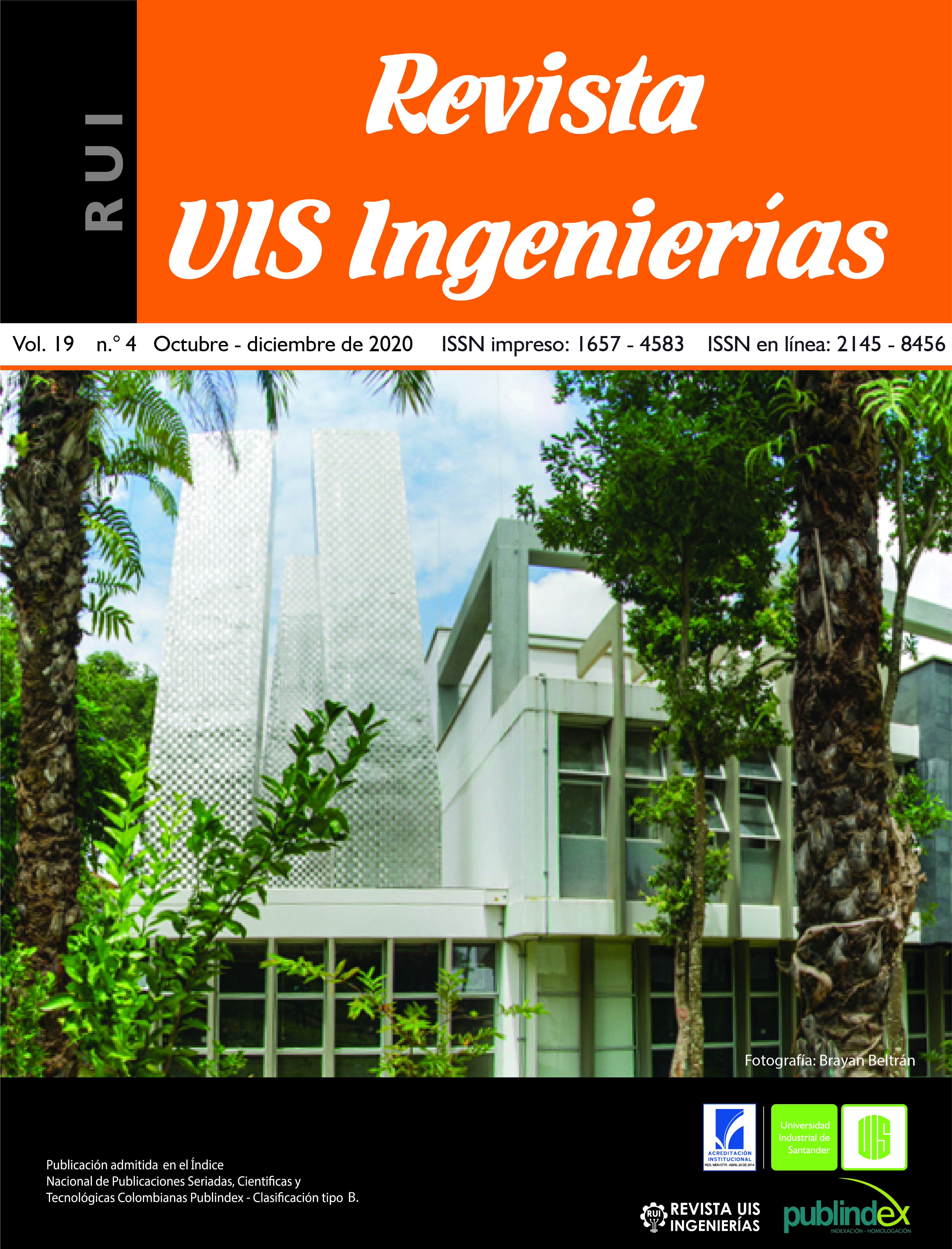Design and simulation of a mechanical system for the machining of parts and printing in 3D (x, y, z)
Published 2020-07-30
Keywords
- CNC,
- module,
- design,
- solidworks,
- machine
How to Cite
Copyright (c) 2020 Revista UIS Ingenierías

This work is licensed under a Creative Commons Attribution-NoDerivatives 4.0 International License.
Abstract
The design and simulation of a multifunctional system for the machining of mechanical parts and printing in 3D (x, y, z) using CAD software Solid works, was used to determine the static behavior of the system with the analysis of tension, deformation, displacement, safety factor, buckling, fatigue and frequency. For the above, it was determined that the lateral base supports a tension of 3.5x108 Pa, causing a displacement of 25 mm and an equivalent unit strain (ESTRN) of 0.0012. And the base guiding a cumulative damage of 300% of deterioration that reduces its useful life to a range between 1x106 and 1x1065 utility cycles and a safety factor (F S) between 104.632 to 7869.86. On the other hand, the transverse base has a maximum cumulative damage percentage of 4.10535 and a life cycle range ranging from 24358.5 to 1x106 with a minimum SF of 5974.
Downloads
References
[2] R. Raghunandan, P. Venkateswara Rao, “Selection of sampling points for accurate evaluation of flatness error using coordinate measuring machine,” J. Mater. Process. Technol., vol. 202, no. 1-3, pp. 240-245, 2008, doi: 10.1016/j.jmatprotec.2007.09.066
[3] F. Bosché, E. Guenet, “Automating surface flatness control using terrestrial laser scanning and building information models,” Autom. Constr., vol. 44, pp. 212-226, Aug. 2014, doi: 10.1016/j.autcon.2014.03.028
[4] W. Makiela, K Stepien, “Evaluation of flatness profiles by means of Wavelet Transformation,” Faculty of Manuf Tech Tuke, Manuf. and Ind. Eng., vol. 11, no. 2, 2012.
[5] P. Bo, M. Bartoň, D. Plakhotnik, H. Pottmann, “Towards efficient 5-axis flank CNC machining of free-form surfaces via fitting envelopes of surfaces of revolution,” Comput. Des., vol. 79, pp. 1-11, 2016, doi: 10.1016/j.cad.2016.04.004
[6] B. I. Oladapo et al., “Experimental analytical design of CNC machine tool SCFC based on electro-pneumatic system simulation,” Eng. Sci. Technol. an Int. J., vol. 19, no. 4, pp. 1958-1965, 2016, doi: 10.1016/j.jestch.2016.08.010
[7] C. C. Hong, C.-L. Chang, C.-Y. Lin, “Static structural analysis of great five-axis turning–milling complex CNC machine,” Eng. Sci. Technol. an Int. J., vol. 19, no. 4, pp. 1971-1984, 2016, doi: 10.1016/j.jestch.2016.07.013
[8] S. Gómez González, El gran libro de solidworks Edición 1. Marcombo S.A, México: Ed. Alfaomega, 2007.
[9] G. Valencia, Estructuras de acero. Diseño con factores de carga y de resistencia, edición 1. Colombia: Escuela Colombiana de Ingeniería, 1997.
[10] S. Segovia, Manual de soldadura. Ejercicios prácticos de soldadura al arco. Electrodo revestido, edición 1, 2012.
[11] I. Jiménez Mesa, J. Diaz-Tendero, J. Suárez Rivero, Dibujo Industrial. Manual De Apoyo Y Docencia, Océano, 20 de septiembre, 2014
[12] T. H. Lin, M. Ito, “Theoretical plastic stress-strain relationship of a polycrystal and the comparisons with the von Mises and the Tresca plasticity theories,” Int. J. Eng. Sci., vol. 4, no. 5, pp. 543-561, 1966, doi: 10.1016/0020-7225(66)90015-2
[13] O. Rojas Lazo, L. Rojas Rojas,” Diseño asistido por computador,” Industrial Data, vol. 9, no. 1, pp. 7-15, 2006.
[14] K. S. R. Chandran, “A physical model and constitutive equations for complete characterization of S-N fatigue behavior of metals,” Acta Mater., vol. 121, pp. 85-103, 2016, doi: 10.1016/j.actamat.2016.09.001
[15] A. May-Pat, F. Avilés, “Análisis numérico de fractura interfacial en columnas sándwich sometidas a compresión axial,” Ingeniería, vol. 11, no. 3, pp. 21-32, 2007.
[16] “Matlab”, MathWorks, 2016
[17] J. L. Romero, E. M. López, M. A. Ortega, O. Río, “Análisis de pilares con deformación por cortante mediante elementos finitos y acciones repartidas equivalentes,” Rev. Int. Métodos Numéricos para Cálculo y Diseño en Ing., vol. 33, no. 3-4, pp. 280-289, 2017, doi: 10.1016/j.rimni.2016.06.002
[18] A. Sáenz López, “Análisis del factor de intensidad de esfuerzo utilizando el método de los elementos finitos extendidos,” Revista de Arquitectura e Ingeniería, vol. 7, no. 1, pp. 1-11, 2013.
[19] H. Mao, R. Rumpler, P. Göransson. “An inverse method for characterisation of the static elastic Hooke’s tensors of solid frame of anisotropic open-cell material,” International Journal of Engineering Science, vol. 147, pp. 1-18, 2020, doi: 10.1016/j.ijengsci.2019.103198

